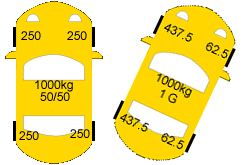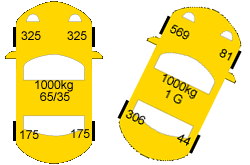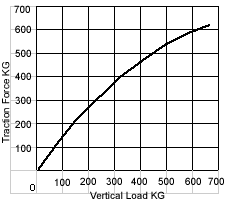Roll Stiffness & Weight Transfer
You'll have often heard front wheel drive cars referred to in a rather disparaging way by many so called experts. A lot of people just assume front wheel drive = understeer. Granted it is not the best layout for a race car (even though at one point FWD even made it into F1) as the table below shows:
| Drivetrain | Directional Stability | Traction | Cornering Balance | Drivetrain Weight |
| FWD | ++ | - | -- | + |
| Front RWD | + | + | + | - |
| Mid RWD | - | + | ++ | + |
| Rear RWD | - - | ++ | - | + |
| 4WD | + | ++ | + | -- |
As you can see from the table Front Wheel drive excels in two areas - Directional Stability and Drivetrain Weight. However with traction and cornering balance being much more important for a racecar, how is it in reality that where a front wheel drive and rear wheel drive class are closely regulated (for example touring cars) that the front wheel drive will often win?
It is partly due to the directional stability which enables the aggressive driver of a front wheel drive car to literally throw the car through a chicane with their foot planted where as the rear wheel drive layout tendency would be to spin in such a situation.
The real reason though for the comparatively small differences between front wheel drive and rear wheel drive (up to a certain horse power level) is much more to do with the management of weight transfer.
In section 1 we started to discuss weight transfer and how this impacts on the load the tyre sees. Weight transfer in a car is a function of Lateral Acceleration, Track Width, Centre of Gravity Height (CG Height) and Weight. The following formula calculates the amount of weight transfer:
Weight transfer = ( Lateral acceleration x Weight x Height of CG ) / Track width
In addition another formula expresses the theoretical maximum corner speed before the vehicle tips over:
2.74*SQRT[(Radius of turn feet *Track width feet)/(CG Height feet)]
Looking at the formulas quite easy to see that the only way to reduce weight transfer for a given lateral acceleration is to either widen the track, lower the CG Height or reduce the vehicle weight.
Now lets move this onto some practical examples to see what happens to the tyres. Assumptions - the vehicle weighs 1000kg and has a CG Height of 600mm and a track width of 1600mm. Weight distribution is 50/50. The car is rounding a corner and generating 1.0G of lateral acceleration.

You can see clearly that the 375 KG of total weight transfer has a dramatic effect on the load distribution of the tyres.
Now what about a FWD vehicle with a more typical 65/35 % weight split front to rear?

As you can see in the FWD example the outside front tyre is now experiencing 57% of the total weight of the car.
The key to making the car round the corner at maximum speed is to ensure that the tyre is generating the maximum amount of lateral force for the given vertical load. This is easily calculated by dividing the lateral force by the vertical load. Below is a vertical load vs lateral force chart for a tyre.

So for example at a load of 400 kg this tyre generates traction force of 465kg. Traction Force/Vertical Load = G Force. In this example this tyre can generate 1.16 G. With a Vertical load of 600kg this tyre generates 600 kg traction force which equals just 1G. At 300 kg this tyre generates 375 kg force which is 1.25 G.
Looking at the diagrams of the cars above you can now see why the Front wheel drive car with 65/35 split will not be able to corner as fast as the 50/50 Split RWD car.
RWD 50/50
Using this tyre the traction force for a vertical load of 437kg is approx 495kg. So the total traction force is 990kg and the total load 874kg giving G- Force of approx 1.13 G .
FWD 65/35
The 65/35 split car generates a traction force on the front tyre of approx 575kg for a load of 569kg. On the rear in generates approx 375 kg traction force for vertical load of 306 kg. Total traction force 950kg and total load again of 875kg equates to G-Force of 1.08G
So that's it then? FWD will always be worse than RWD?
Well for example not if the FWD car had a lower CG height and wider track width to compensate for the inferior weight distribution. Also tyres could be carefully specified to ensure the load vs traction force ensured front and rear axles worked better together.
Roll Stiffness is arguably a most important aspect of chassis tuning. When the vehicle rounds a corner the axle with the most roll stiffness attracts the most weight transfer. Herein lies one “Secret” of chassis tuning. Essentially the strategy is to change roll stiffness, largely by upgrading anti-roll bars to ensure that the tyre loads are distributed to optimise outright grip. So in the example of the front wheel drive chassis, but adding a much stiffer rear anti-roll bar, the proportion of overall weight transfer to the rear outside tyre under cornering loads will be increased. Conversely in this instance the load on the front outside tyre will be reduced. As we have seen from the tyre data this may enable the front wheel drive car to corner as fast as the rear wheel drive car.
It is worth remembering though that if you go too far with front or rear roll stiffness you will lift the inside wheel. Some people seem to think this is a good thing. It's not. Granted it's very common to see a FWD lift a rear or a RWD lift a front wheel but then you are driving a 3 wheeler. The axle that has lifted can no longer transfer any more load and if you do get any more GForce it will transfer the remaining weight via the other axle. This then generates excessive roll with any more weight transfer than then what happens is the car then "falls over" onto the wheel diagonally opposed. The solution is sometimes counterintuitive. On a FWD car you may actually need some more front roll stiffness rather than softening off the rear bar. On a rear wheel drive that is lifting the front wheel you probably need more rear roll stiffness rather than softening the front.
Ultimately beyond a certain power level a FWD car will not be able to cope with the fact the front wheels have both tractive and cornering loads as well as steering to deal with.
However careful attention to roll stiffness and weight transfer has ensured a long and successful racing history which continues today for the rear engined Porsche 911. Which on paper has only traction in its favour.
This is of course a fairly simplistic approach to a very complicated subject. There are a number of other factors that you will need to consider, namely:
-
Roll Centre Location
-
Dynamic Roll Centre
-
Camber
These will be discussed in the next Chapter - Geometry






